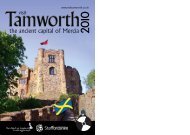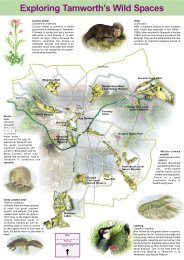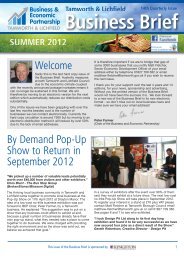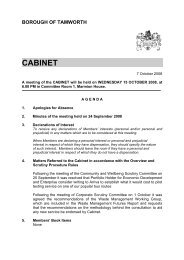Conservation Management Plan - Tamworth Borough Council
Conservation Management Plan - Tamworth Borough Council
Conservation Management Plan - Tamworth Borough Council
Create successful ePaper yourself
Turn your PDF publications into a flip-book with our unique Google optimized e-Paper software.
1.2.6 The Castle Collections<br />
The Castle was purchased by <strong>Tamworth</strong> <strong>Borough</strong> <strong>Council</strong> in 1897 without any contents. This means that although<br />
the records of the appearance of historic room interiors exist as either historic photos, sketches, paintings and<br />
inventories, there is no original furniture or other personal items to ‘dress’ them. The lack of furniture and other<br />
effects belonging to the families who lived in <strong>Tamworth</strong> Castle, is presumably because these effects were sold<br />
off in a succession of house sales. This to some extent diminishes the significance of the historic interiors, but also<br />
provides more flexibility in the way they are displayed. It is clear from consultation that the majority of visitors to<br />
the castle assume that the furniture and other items within the room sets they gaze at are original to the castle.<br />
The collections have been acquired since 1897 through gift, bequest, long term loan from other museums, and<br />
through purchases. A significant section of the collection comprises items that were acquired around 1897 to<br />
provide the castle with display items. This included a natural history collection from the <strong>Tamworth</strong> Natural History<br />
Society, a collection of arms and armour and a collection of Saxon coins from the <strong>Tamworth</strong> mint.<br />
Items were acquired with little rationale until the 1960s because there was no professional curator until the 1960s<br />
and no formal collections policy until the 1980s.<br />
Some rationalisation took place in the 1980s when three collections were transferred to Birmingham Museums and<br />
Art Gallery which had the resources to care for them. These were the Egyptology, Ethnography and Natural History<br />
Collections which formed part of the Allsopp collection, a private collection formed over a lifetime by <strong>Council</strong>lor<br />
Frederick Allsopp in 1952.<br />
Cases of stuffed birds were formerly displayed in the Norman Tower and in the drawing room in the south range.<br />
During the consultation for this <strong>Conservation</strong> <strong>Management</strong> <strong>Plan</strong> many older residents spoke fondly of the stuffed<br />
polar bear that was formerly displayed in the Great Hall. This was disposed of in the 1960s and sadly there don’t<br />
appear to be any photos of this iconic exhibit.<br />
Since 2002 active collecting has slowed, with an average of 40 items per year being accepted. Objects have been<br />
specifically collected for the handling collection, and some reserve collection pieces have been de-accessioned into<br />
the handling collection.<br />
Given the lack of rationale the collections of <strong>Tamworth</strong> Castle are diverse and vary in quality, size and significance.<br />
Some of the collections have come into existence through the collecting activities of local philanthropists during<br />
the nineteenth century and accordingly reflect their tastes; others through local archaeological excavations,<br />
probably the most significant of which is the excavation of the site of the Saxon Watermill in Bolebridge street. The<br />
large structural timbers from this excavation remain buried within a water treatment plant along Lichfield Street,<br />
but are part of the castle collection. Other items within the collection include replicas commissioned and acquired<br />
by <strong>Tamworth</strong> Castle and as donations from private individuals.<br />
Due to the documentation backlog it is only possible to estimate the number of items within <strong>Tamworth</strong> Castle’s<br />
collections. Estimates in the 1980s put the figure between 5000-8000 items, although more recent estimates have<br />
suggested around 1200 items.<br />
The reserve collections are known to consist of the following:<br />
Archaeology; Art; Coins and Medals; Allsopp collection(weapons, armour, books); Edith Gater Collection (designs<br />
and examples of tube lined ceramics); Gibbs and Canning Collection (mainly architectural terracotta and company<br />
records); Skeys pottery collection; Mac Gregor Collection (Egyptology); Peel Collection; General social history<br />
and costume; documentary archive; photographic archive and <strong>Tamworth</strong> Trade records and a fossil and mineral<br />
collection donated by <strong>Tamworth</strong>’s natural history society in the 1890s.<br />
The handling collection<br />
The handling collection makes social history objects available to schools and other groups available for handling in<br />
a series of boxes, based on the following themes, influenced by the need of the National Curriculum:<br />
Britain since 1948; holidays at the seaside; Victoriana; Victorian childhood; Victorian housework; Victorian working<br />
life; Edwardian leisure time; toys from the past; Britain since the 1930s, domestic life; Britain since the 1930s, Saturday<br />
night out.<br />
<strong>Tamworth</strong> Castle <strong>Conservation</strong> <strong>Management</strong> <strong>Plan</strong> www.marionblockley.co.uk<br />
Part 1<br />
45







